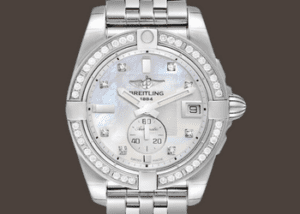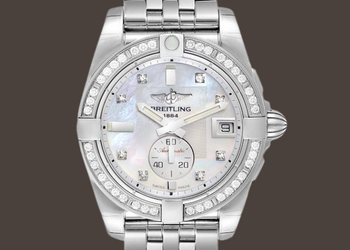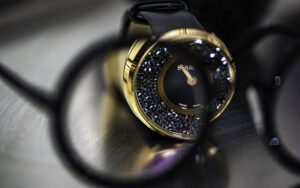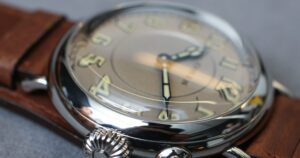When Léon Breitling opened his first workshop at Place Neuve 1 in Saint-Imier, Switzerland, at the tender age of 24, he could scarcely imagine the impact his innovative, tech-driven timepieces would have on tool watch history. If you happen to own a Navitimer or a Top Time, you know what I’m talking about. A Breitling isn’t just a watch—it’s a technical work of art.
As Breitling toasts 140 years of high-precision watchmaking, let’s look at how the brand became a household name among professionals and enthusiasts alike in this two-part series.

1884 to the 1940s: The Early Years
Léon Breitling’s passion for developing chronographs and timer functions factored significantly into his early success as a sought-after watchmaker and watch repair expert. The technology was still very new and presented a tremendous challenge for the young man, but he was undaunted. With the advent of flight and car travel, he knew the horology industry needed to answer the call for more precise timekeeping instruments.
In 1892, Breitling expanded his workshop by transferring to a factory in the heart of the Swiss watch world, La-Chaux-de-Fonds. It was a good move for the company, as shortly after that, he introduced his first patented movement with an 8-day power reserve. It was an astonishing feat since most mechanical watches for that time and well into the 20th Century usually only had a power reserve of two days.
That year, Breitling also invented the pulsograph, a timepiece equipped with a logarithmic scale to measure a person’s pulse. Three years later, he developed a chronograph that sported an accuracy of two-fifths of a second. Finally, in 1905, Breitling patented a pocket-watch tachymeter that allowed race cars to measure their speeds between 15 and 150 kilometers per hour. Until his death in 1914, Léon Breitling continued to work on designs for his greatest invention—a wearable chronograph.
Unfortunately, he would not live to see it. Instead, his son, Gaston, was the one to introduce the company’s groundbreaking worn chronograph with a pusher at the two o’clock position in 1915.
The new owner of the family business was a lot like his father in his passion for innovation and the further development of wearable watches. In 1923, he would refine the 1915 chronograph by putting the “reset to start” and “start/stop” functions in two separate buttons (one on the crown and the other on the pusher). This improvement was infinitely more user-friendly than the original, where all three functions were controlled with one pusher.
Gaston’s tenure at the helm of Breitling didn’t last long, though, as he died only a few years later in 1927. It would be five more years before the last Breitling arrived on the scene. Much like his grandfather, Willy Breitling was only a wisp of an adult when he took the reins at the company at age 19. But what he lacked in years, he made up for in watchmaking and marketing genius.
In 1934, Willy would be the one to create the brand’s iconic two-pusher chronograph design (one at two o’clock and one at four o’clock) that to this day remains the centerpiece of Breitling’s professional timepieces.
Air, Sea, and Space
Worn chronographs quickly distinguished themselves as vital professional tools for soldiers battling in the trenches during WWI since pocket watches proved fragile and unwieldy during combat. Wartime reliance on wearable precision timepieces and the need for more accurate onboard instrumentation set the stage for Breitling’s jump into military and commercial aviation.
While the newly-formed “HUIT Aviation” department focused primarily on cockpit timing instruments, the extensive research and development there soon translated into technology Breitling could also apply in wristwatches.
For example, in 1940, the brand introduced its first chronograph with a circular logarithmic slide rule. This innovative addition allowed professionals to perform all kinds of complex mathematical calculations simply by using their watch. Breitling also made the new Chronomat easy on the eyes with soft lines and a slim case in a nod to his personal sense of style. The timepiece was an instant hit.
In 1952, Breitling’s footprint in the aviation industry grew larger with the launch of the iconic Navitimer (ref 806). By adjusting the Chronomat’s slide rule to accommodate aviation functions, Willy Breitling’s Navitimer quickly became a favorite among pilots everywhere. Two years later, in 1954, the Aircraft Owners and Pilots Association (AOPA) adopted the Navitimer as its official timepiece.
The Navitimer’s popularity was so great that Breitling made the watch available to the public in 1956. Just a year later, Breitling took to the depths of the sea with the launch of its SuperOcean line—a chronograph (ref 807) and a time-only watch (ref 1004)—featuring a rare water tightness rating of 600m.
But he wasn’t finished exploring. With the advent of the space race, Willy and his team saw a new frontier open up for professional timekeeping. In 1962, the Cosmonaute became the first Swiss wristwatch to orbit the Earth. It was a bespoke piece for Lt. Commander Scott Carpenter, a Mercury Program astronaut and fan of the famous Navitimer. Carpenter requested that Breitling create a similar timepiece with a larger bezel and a 24-hour dial. Word of the Cosmonaute’s epic voyage to space circulated quickly, and Breitling introduced the watch to the public a short time later.
In next month’s installment, we’ll discuss how Breitling pivoted successfully from a technical watch powerhouse to a coveted luxury brand.




